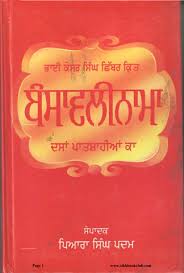
BIHANGAM, from Sanskrit vihang which means a bird, is a term applied to wandering ascetics who lead a life of complete detachment. A Biharigam is a celebate who lives in poverty renouncing all worldly ties and follows the path of holiness. In the Hindu tradition, he, abjuring religious dogma, worships Siva, Rama and other incarnations. Bihangams, among Sikhs, are likewise holy men who do not marry and who shun worldly ambition and temptation. The object of their devotion is the One Supreme Being.
CHAMKAUR SAHIB (30° 53\'N, 76° 25\'E) in Ropar district of the Punjab was the scene of two engagements which took place here between Guru Gobind Singh and the imperial troops in the opening years of the eighteenth century. There exist six shrines in the town commemorating the events of those fateful days. GURDWARA DAMDAMA SAHIB marks the Spot where Guru Gobind Singh first alighted upon reaching Chamkaur late on 6 December 1705. The site was then a garden belonging to Rai Jagat Singh, the local landlord.
DARBARA SINGH, DlWAN (d. 1734), originally from the mercantile community of Sirhind, became a Sikh receiving the initiatory rites on 30 March 1699, the day the Khalsa was created, and took part in the battles of Anandpur. During the period after Banda Singh he commanded much esteem as a veteran fighter and as diwan, i.e. commissar in charge of rations and forage.










